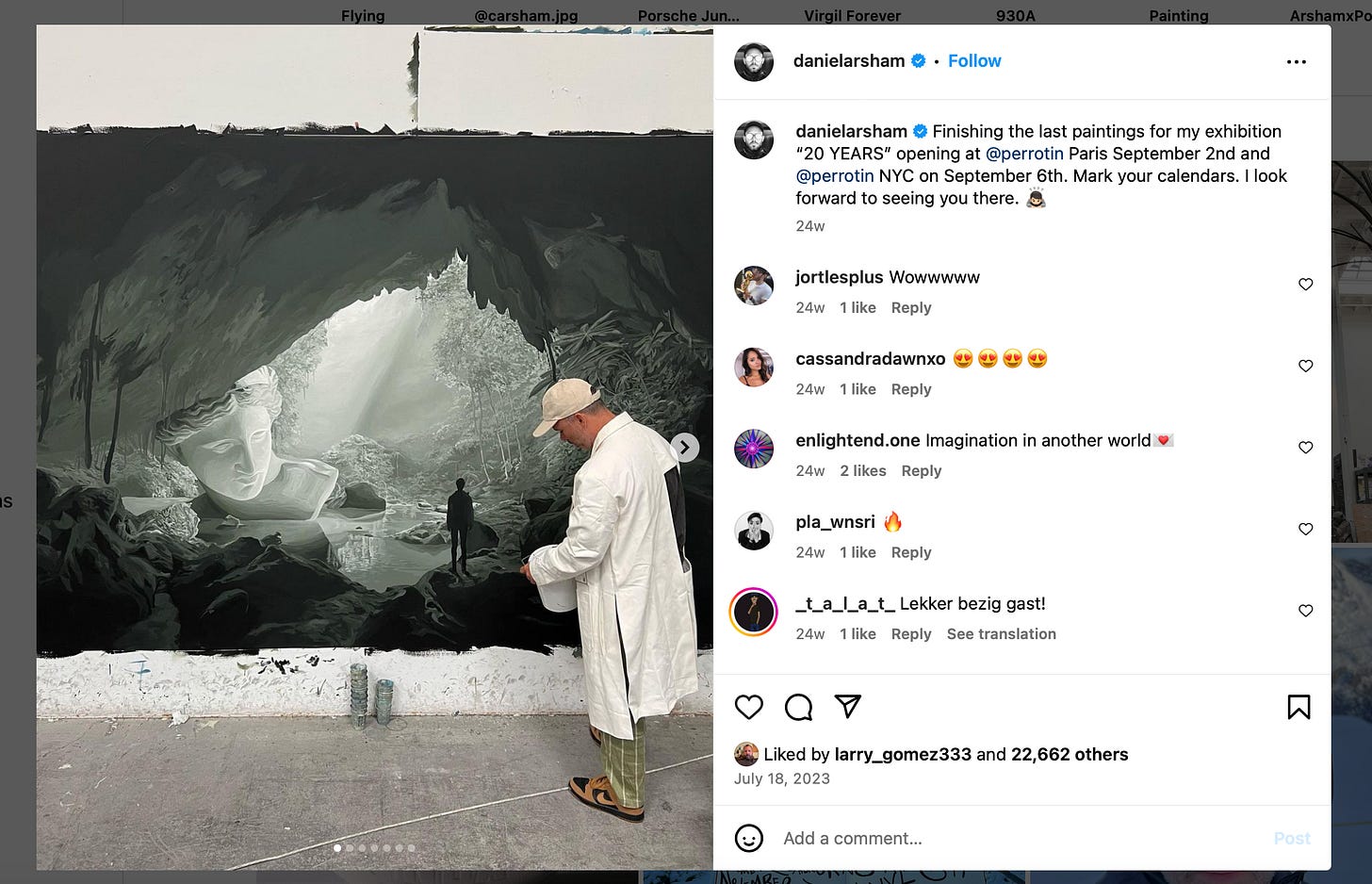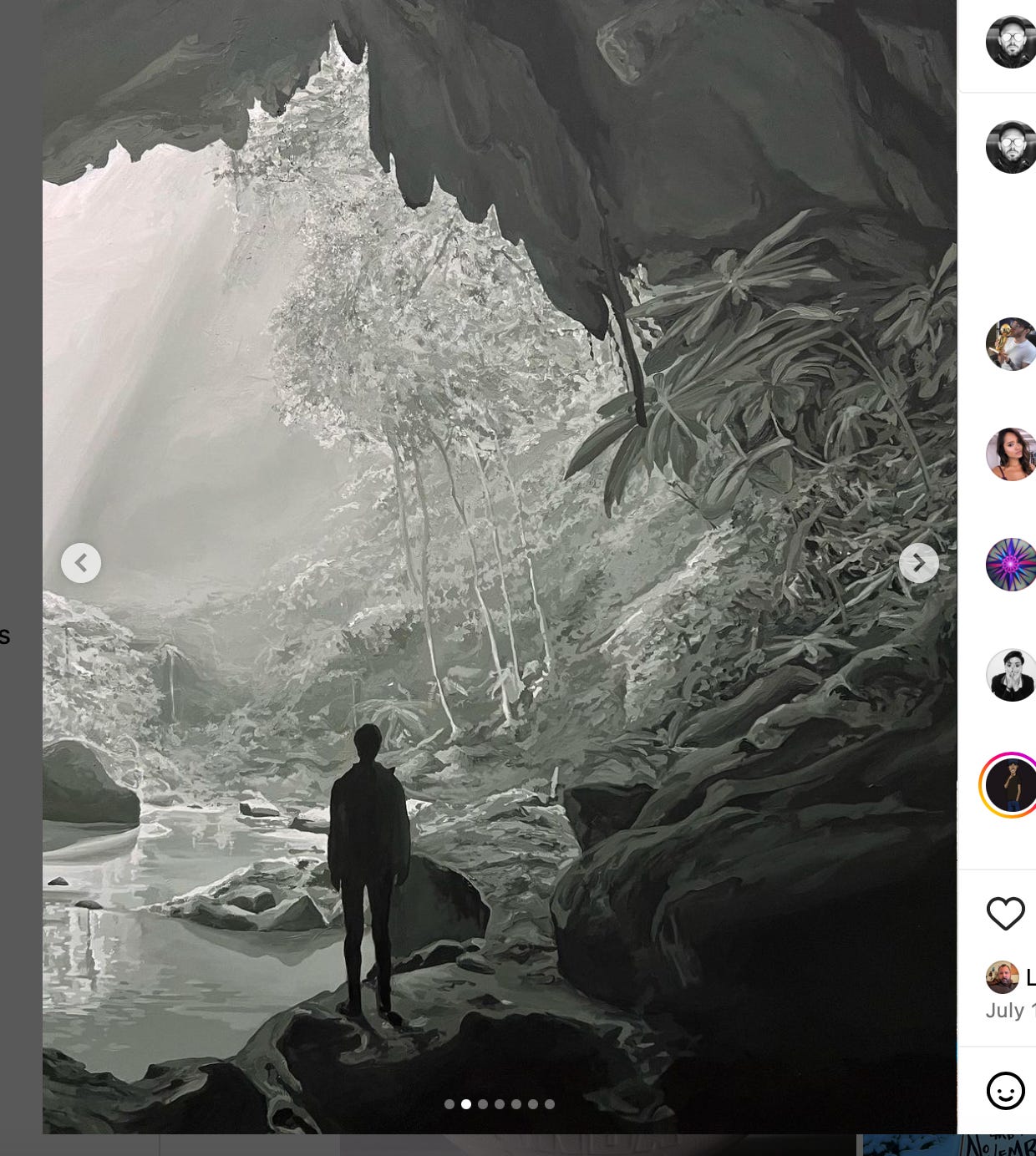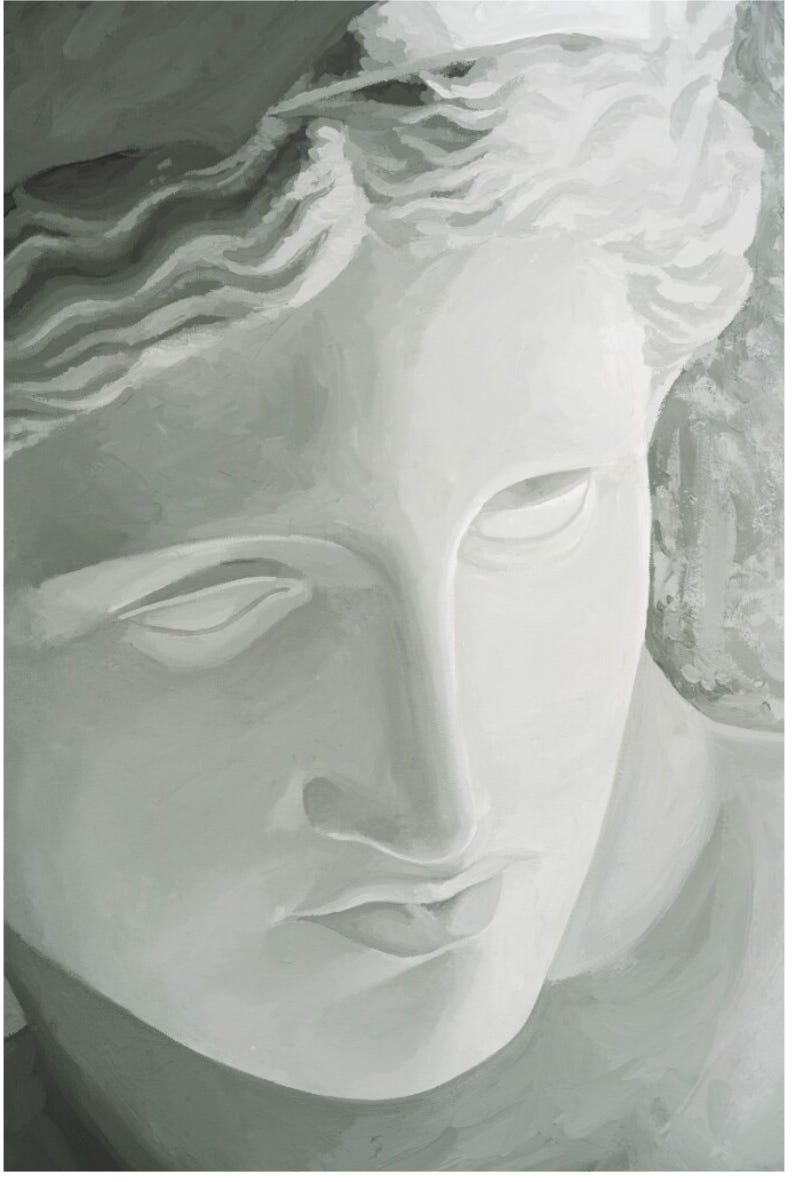Daniel Arsham is one of the most important artists alive today.
I confess, I only heard about him recently and through an Instagram post nonetheless. However, the post was so appealing to me that I became an immediate fan and dove head first into his body of work
The post was a picture of the painting, Cenote of the Sublime,, RHÔNE, which is part of his “20 Years” exhibit that was opened in Paris and New York at the Perrotin gallery at the end of 2023.
Here’s a screenshot of the painting that caught my eye and also gives an idea of the scale.
And here’s a photo of the full painting courtesy of the gallery.
Its hard to imagine anyone interested in western philosophy, Plato or classical Greece not immediately drawn to a photo like this which immediately invokes Plato’s “allegory of the cave”, an allegory from the Republic that is foundational to the thinking of Western philosophy.1
In the foreground is the silhouette of a man, dressed in modern day clothing, who has paused, in awe perhaps, and is looking out of the cave at a ray of light that is shining on the face of a Greek statue that appears to have fallen.
The painting seems to capture one of the key motifs of the hero’s journey, escaping darkness and finding the light of truth. But what is this truth? Something from the past? Or maybe it’s a dystopian image captured after the “fall” and the discovery of some lost civilization in the vein of Planet of the Apes.
The person emerging from the cave appears to be looking directly at the fallen bust. The light illuminates a relic, the discovery is something of the past, an ancient statute that seems remote and out of place.
The title of the painting is “Cenote” which is a word that originated from the Mayan world of the Yucatan. Cenotes are defined as a natural pit or sinkhole, resulting from the collapse of limestone bedrock that exposes groundwater2.
The broadleaf foliage looks tropical, something that would grow closer to the equator, not around the mediterranean.
The statute of the Greek goddess is half illuminated by the sun and appears downcast as if looking at its reflection in the creek that emerges from the cave, as if forever remembering its former life and glory.
The painting itself is a masterful study in the gradual progression of light and shadow through the subtle shades of grey. On this use of monochrome painting which is standard for Arsham who states, “one of the reasons why my works have always been in these muted tones is because of my severe color blindness”3
But the affect is near and dear to philosophy. There was an old rivalry between painting schools who stressed form versus those who stressed color. The formist school, best represented by Nicholas Poussin, saw form linked to rationality and the intellect while his rival, Delacroix believed color should be the dominant factor for painting with its ability to affect the senses.
Hegel best summarizes the position of classical philosophy on this matter,
“When philosophy paints its grey on grey, then has a shape of life grown old. By philosophy's grey on grey it cannot be rejuvenated but only understood. The owl of Minerva spreads its wings only with the falling of the dusk.”
Although broken and captured in the middle of the day, the eternal dusk provides an atmosphere for Athena’s owl to fly albeit in the shadows of the painting.
For Arsham, who is also an acclaimed sculptor, architect, and designer, Greek sculpture is a recurring theme in his work. He was given access to all of the molds that exist at the Louvre in Paris and for over a decade has exhibited Greek figures in both painting and sculpture reflecting this influence.
The work with Greek sculpture and architecture has brought him close to the study of archaeology. Along with this his works of the past he contemplates the future by sculpting modern day objects in a similar style to appear as relics of the future.
These works have also lead to partnerships with the famed jewelry company Tiffany’s merging the past with high end design and decorum of the present for there is no better way to embody the present than through wearable art.
In another series of paintings, he pits the past and future together through a two sided portrait. One half is the familiar Greek female statute, the other an anime influenced avatar. An archaic past married to a cyberpunk future.
For the description of this painting he posted on Instagram, Arsham writes, “Recently, long ago and far into the future.”
On this importance of temporality in his work he states,
“Most of the projects I work on are less of a message or meaning… They’re an invitation to reimagine your position, both in relation to these works… and having been confronted with objects that are floating in time, maybe you reimagine your own position within time.”4
By his own description, the work is meant to affect the viewer, to have them question their own relation to time. In this way, his work is in line with the central motif of modernity, subjectivity. The meaning of art is dependent on what it means to the viewer.
But perhaps there’s something else at play here.
Images of the past, looking back but also looking forward. Relics of the present that are found in the future. What is their meaning and is there some essential truth to them behind the vocabulary of irony and pun encoded into the work by high end society.
Art has the tendency to transcend time and the meaning of great artwork usually only formulates centuries after it was created. This is the curious nature of time. Art, like archaeology, makes objects in the future mean something that they didn’t mean in their own time.
Some writers call this a “false memory.” In psychology a false memory is a phenomenon where someone recalls something that did not actually happen or recalls it differently from the way it actually happened. In cyberpunk philosophy, taking inspiration from science fiction, false memories are memories of the past that are revealed as tactics of the future to infiltrate the present.5
Otherworldly intelligences, like oracles and now AI(?), have the ability to see into the future to influence the present but, in order to gain trust, they have to be rooted in a tradition. The oldest ruins and books were the ones that had the ability to see furthest in the future, think Delphi, the I Ching, the Vedas and the Pyramids.
This is a curious idea that had me thinking. Why is it that UFO’s, now called IAPs, are always linked to some distant future and also to our remote past? If you listen to any podcast or channel that deals with UFOs, chances are it will also discuss ancient civilizations like Egypt, and theorize that the pyramids were built by super intelligent beings that are no longer here.
Along the same lines, one recent theory on UFO/IAPs are that they are really the humans from the future that have come back to warn us about some danger now that is threatening the planet, ie. nuclear war or climate change.
New myths and stories of a shared imagination now cloaked in technology and intelligence.
Science fiction writers had a hand in writing the future by creating stories and terminology that would be later incorporated into the technology lexicon. Did they somehow divine these ideas by a future that opened itself into them? Did their imagination create it out of thin air and in the process made it real by influencing later technologists? Was the future already present in the past, a la Heidegger’s notion of ecstatic time, and they were just able to see its contours clearer than anyone else?
In some ways Arsham too is playing with the future by creating with the past.
Returning to his painting, Cenote of the Sublime, we emerge from the cave to find a past, in some strange way our own past, our own not due to any ethnicity or shared geography or language, but our own more like a deja vu. A memory that is true simply because we remember it. Wether it happened or not is not really worth investigating because that couldn’t be definitely answered and analyzing it would, in the end, just erase the memory from our own memory.
For an upcoming lecture on the Republic that promises to be eye opening, check out the course available here from the Halkyon Guild.
Ibid.
Nick Land, Fanged Noumena, editor’s Introduction, p. 38.










Is there a list of his works with their locations, and are any of his Works are in the Washington DC area?
Yet another fascinating, mind-expanding essay. Keep up the great work, Larry -- I always find it to be a worthwhile, thought-provoking read!